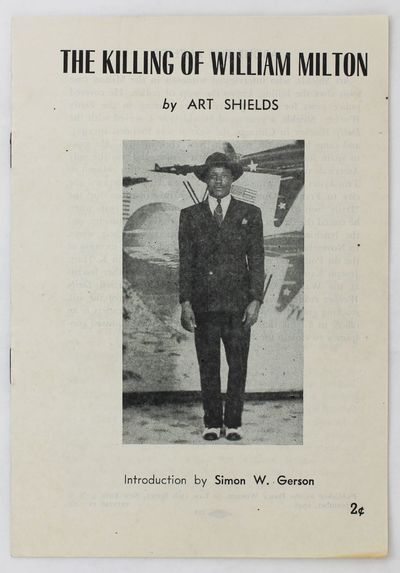1948 · New York
by [African Americana]. Shields, Art
New York: The Daily Worker, 1948. Near fine.. 16pp. Illustrated. Original pictorial self wrappers, stapled. Mild toning and light wear. A scarce account of the events surrounding the death of William Milton, described as "a useful, hard-working, law-abiding citizen...a devoted husband and loving father...sympathetic to his neighbors' problems...what people call a good man" who was also "a Negro and so marked out for that special torture that American society visits upon men and women who are colored." On July 14, 1948, Milton was killed by Brooklyn Patrolman Peter Kilcommons in the hallway of his own building. Milton and three friends ran from police after being thrown out of a Williamsburg bar by a racist bartender named Charles Kennefick who "didn't want Negroes around."
Kilcommons chased Milton to his front door, then shot him once in the back and twice in the chest in front of about ten witnesses, including Milton's wife Irene and their son, Eugene Milton. Eugene describes the incident in a heartbreaking passage: "I saw Daddy drop as the first bullet hit him.... I saw Daddy drop and then stagger inside. Kilcommons and O'Neil were shooting at him as he went in." There are also further accounts of the shooting recorded here from young neighbors. The text also includes the measures sought by the Committee for Justice in the Milton Case. The Committee argued for the dismissal and indictment of Kilcommons and O'Neil, the dismissal of Police Commissioner Wallander, financial support for Irene Milton, and for continued support of Milton's brother, Joseph, who was with William in the bar on the fateful night. Joseph was charged with felonious assault on the bartender Kennefick after William was killed, likely as a cover for the police in William's killing. Shields argues a motive for the arrest and beating of Joseph Milton: "The cops were trying to make him confess that William and himself had started the fight. The cops thought that such a 'confession' would give them an 'out' for the killing."
A possible motive for the killing of William Milton also emerged after his murder. Milton was a member of the Communist Party and a community activist in New York who was often critical of the police violence he encountered in the city. He would also bring copies of The Daily Worker to his neighbors, and was instrumental in organizing a renter's strike in a nearby building. Milton was especially vocal in his criticism of police following the killing of two African-American men by a police officer named Joseph Romeika in Freeport, Long Island. Four young African-American siblings named Ferguson - Charles, Joseph, Alonzo, and Richard - three of whom were U.S. Army veterans were refused coffee by a white manager of a diner. After they vigorously protested, the manager called the police on the brothers. They left but were soon confronted by Romeika, a rookie police officer. Romeika lined the men up and after two of the brothers protested, Romeika kicked them in the groin and shot them, an eerily-similar situation to the one that eventually led to Milton's murder.
The author of the present work, Art Shields, was a legendary labor journalist who had previously written about the Sacco & Vanzetti case and would spend his career on the side of unions and laborers, notably miners. He was highly critical of police actions such as the one recorded here, which he described "as brutal a homicide as if the cops had been working for Heinrich Himmler, the Nazi Gestapo leader, instead of for Police Commissioner Arthur Wallander of New York." The Introduction was written by Simon W. Gerson, one of the foremost leaders of the Communist Party in the United States and editor of The Daily Worker, who writes passionately about the murder of Milton: "Yes, William Milton lived under Jim Crow right here in New York. In fact, he died from Jim Crow. He was lynched, my friends, lynched. What matter is it if a man is lynched by a hempen rope from a Georgia cottonwood-tree or lynched by a police revolver in the trigger-happy hands of a Brooklyn cop?" The penultimate page of the pamphlet contains a group photograph which includes Gerson, along with a Brooklyn councilman, Mrs. Joseph Milton, Irene Milton, and Eugene Milton "at Madison Sq. Garden Rally" presumably in support of the Committee for Justice in the Milton Case. An important story that still resonates today about police crimes against the African-American population. (Inventory #: 4781)
Kilcommons chased Milton to his front door, then shot him once in the back and twice in the chest in front of about ten witnesses, including Milton's wife Irene and their son, Eugene Milton. Eugene describes the incident in a heartbreaking passage: "I saw Daddy drop as the first bullet hit him.... I saw Daddy drop and then stagger inside. Kilcommons and O'Neil were shooting at him as he went in." There are also further accounts of the shooting recorded here from young neighbors. The text also includes the measures sought by the Committee for Justice in the Milton Case. The Committee argued for the dismissal and indictment of Kilcommons and O'Neil, the dismissal of Police Commissioner Wallander, financial support for Irene Milton, and for continued support of Milton's brother, Joseph, who was with William in the bar on the fateful night. Joseph was charged with felonious assault on the bartender Kennefick after William was killed, likely as a cover for the police in William's killing. Shields argues a motive for the arrest and beating of Joseph Milton: "The cops were trying to make him confess that William and himself had started the fight. The cops thought that such a 'confession' would give them an 'out' for the killing."
A possible motive for the killing of William Milton also emerged after his murder. Milton was a member of the Communist Party and a community activist in New York who was often critical of the police violence he encountered in the city. He would also bring copies of The Daily Worker to his neighbors, and was instrumental in organizing a renter's strike in a nearby building. Milton was especially vocal in his criticism of police following the killing of two African-American men by a police officer named Joseph Romeika in Freeport, Long Island. Four young African-American siblings named Ferguson - Charles, Joseph, Alonzo, and Richard - three of whom were U.S. Army veterans were refused coffee by a white manager of a diner. After they vigorously protested, the manager called the police on the brothers. They left but were soon confronted by Romeika, a rookie police officer. Romeika lined the men up and after two of the brothers protested, Romeika kicked them in the groin and shot them, an eerily-similar situation to the one that eventually led to Milton's murder.
The author of the present work, Art Shields, was a legendary labor journalist who had previously written about the Sacco & Vanzetti case and would spend his career on the side of unions and laborers, notably miners. He was highly critical of police actions such as the one recorded here, which he described "as brutal a homicide as if the cops had been working for Heinrich Himmler, the Nazi Gestapo leader, instead of for Police Commissioner Arthur Wallander of New York." The Introduction was written by Simon W. Gerson, one of the foremost leaders of the Communist Party in the United States and editor of The Daily Worker, who writes passionately about the murder of Milton: "Yes, William Milton lived under Jim Crow right here in New York. In fact, he died from Jim Crow. He was lynched, my friends, lynched. What matter is it if a man is lynched by a hempen rope from a Georgia cottonwood-tree or lynched by a police revolver in the trigger-happy hands of a Brooklyn cop?" The penultimate page of the pamphlet contains a group photograph which includes Gerson, along with a Brooklyn councilman, Mrs. Joseph Milton, Irene Milton, and Eugene Milton "at Madison Sq. Garden Rally" presumably in support of the Committee for Justice in the Milton Case. An important story that still resonates today about police crimes against the African-American population. (Inventory #: 4781)


![Circular. Alcabalas. En Real Orden de 3 Febrero de 1795 Cocedio S.M. a D. Joseph Ignacio de Inciarte por Premio de la Expedicion Que Ofrecio Hacer Desde Cadiz al Puerto de S. Blas y los de Californias... [caption title and first line of text]](https://d3525k1ryd2155.cloudfront.net/h/116/571/1667571116.0.m.jpg)
![[Group of Three Posters Concerning the Activism and Incarceration of Leonard Crow Dog]](https://d3525k1ryd2155.cloudfront.net/h/228/069/1666069228.0.m.jpg)